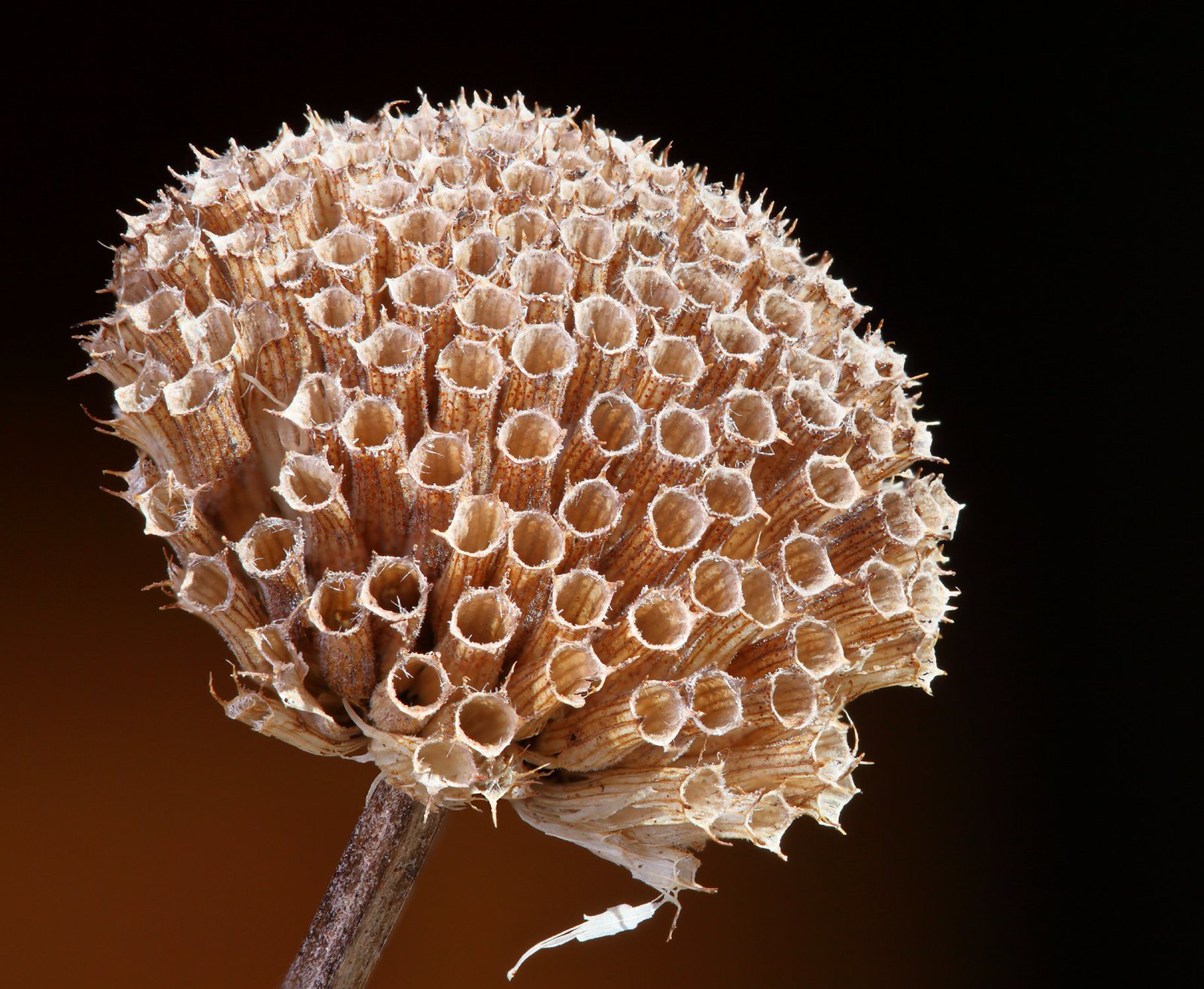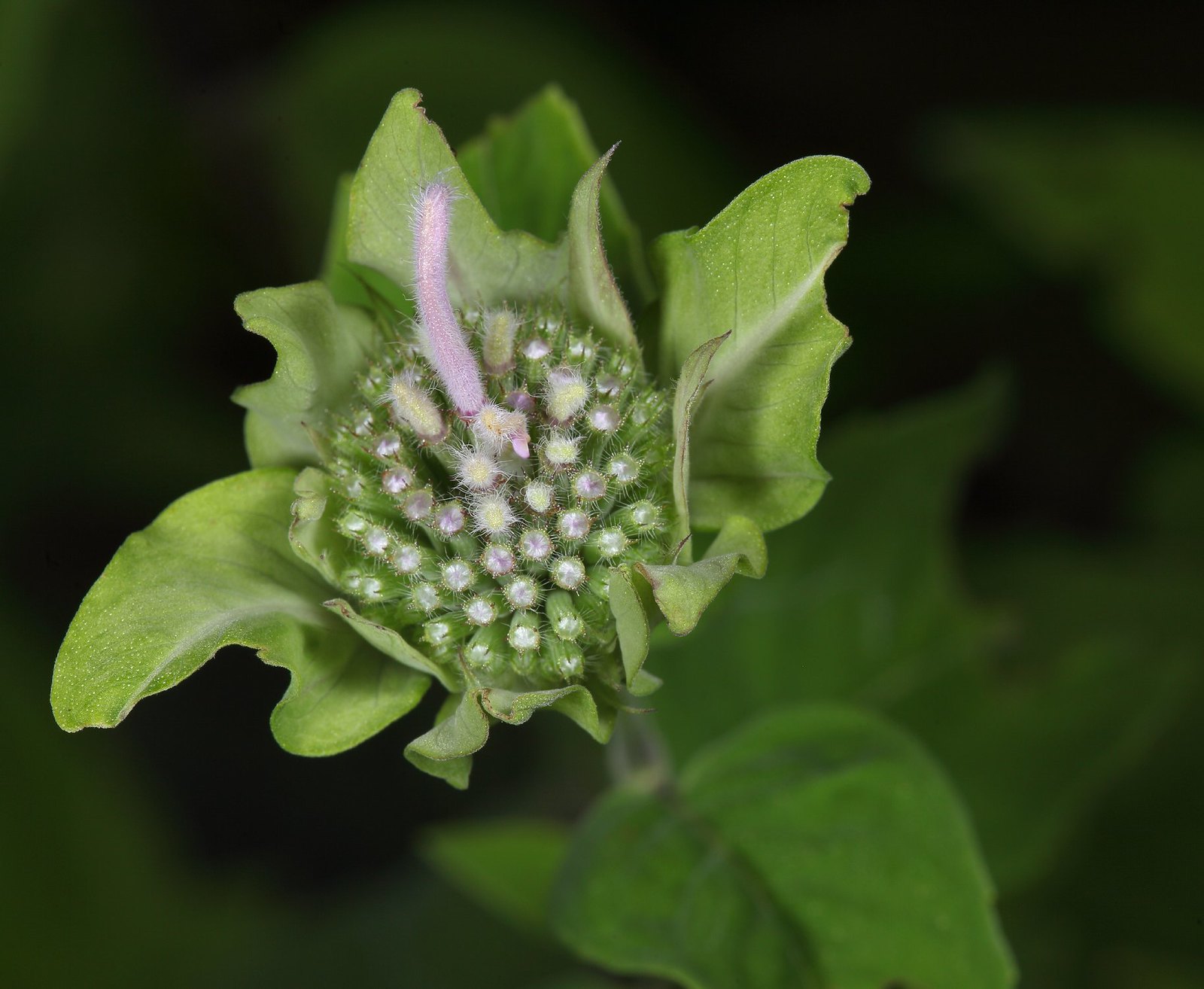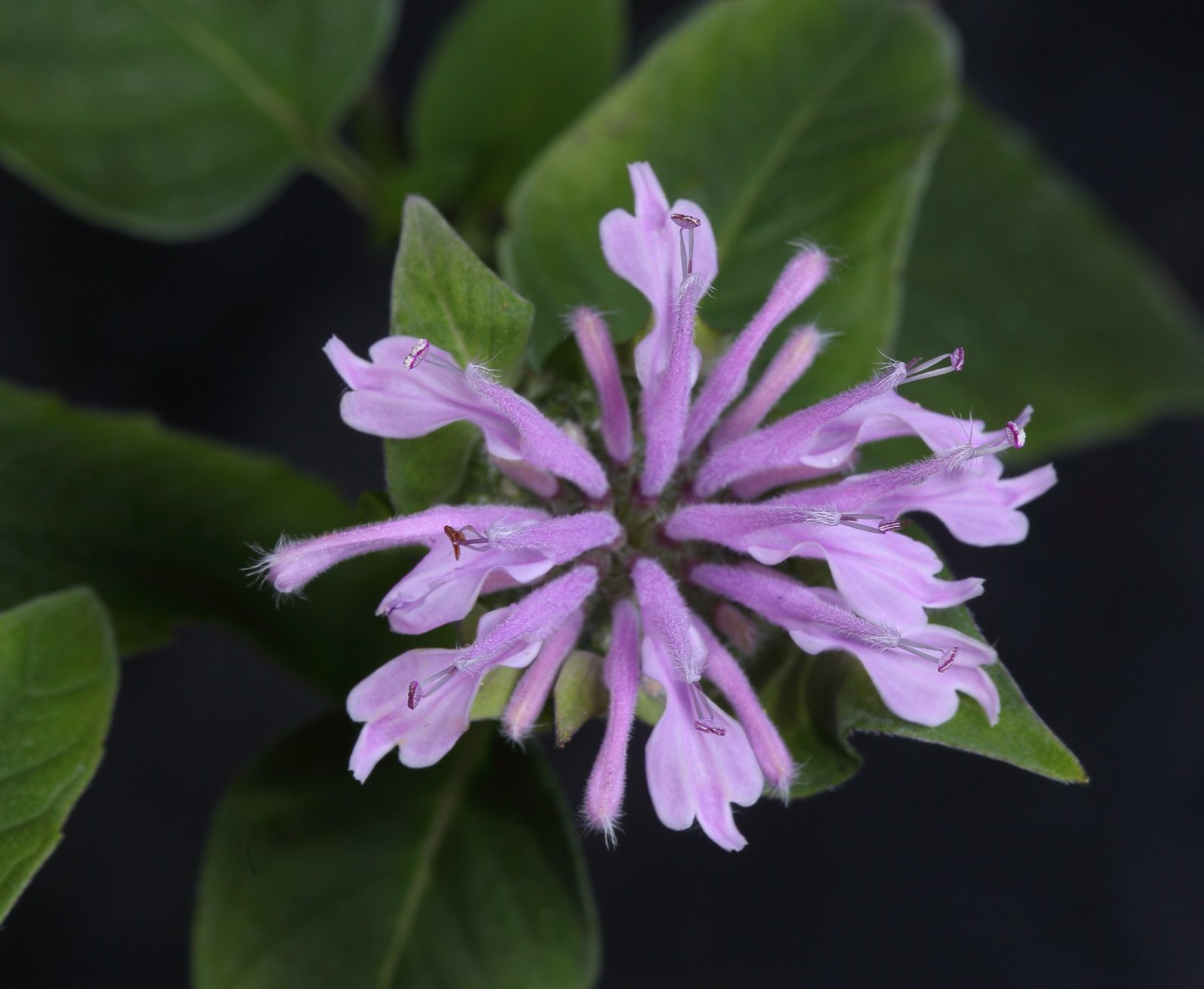Wild bergamot
Mar 21, 2019 18:15:23 #
Here is a 1:1 shot of a seed head from Wild bergamot - Monarda fistulosa - a perennial forb from the Lamiaceae (mint) family that is native to most of North America east of the Rockies. The seed head measures about 5/8 of an inch. 30 or so frames were taken using the Helicon FB tube, and they were combined using Zerene stacker. The width was cropped a little since there was a lot of negative space there. I am including some photos of the plant in various stages of bloom from last July.

Wild Bergmaot I on Flickr
The Monarda genus is endemic to North America, that is to say it is only found in North America, and there are no Old World or southern hemisphere species. There are about 15 or so Monarda species, and four of those are native here in Michigan. Two of those are extremely rare here, Bee balm - Monarda didyma - and White bergamot - Monarda clinopodia. Bee balm is only known to occur on the banks of the Clinton river in southeast Michigan, and White bergamot is only known to occur in Warren Woods in southwest Michigan. Bee balm is popular in gardens, and occasionally escapes. Wild bergamot is common, though I don't see the enormous sweeping stands of it that I remember from years ago. The fourth species that is native here is Horse mint, Monarda punctata. It is fairly common.
Here are the range maps for Monarda species at the Biota of North America project website:
http://bonap.net/NAPA/TaxonMaps/Genus/County/Monarda

Wild bergamot II on Flickr
The genus name, Monarda, honors the 16th century Spanish physician and botanist, Nicolas Bautista Monardes. Fistulosa, the Latin species name, means "pipe-shaped" or "tube-shaped" referring to the florets. The common name, Bergamot, comes from the fact that when the leaves are crushed the aroma is reminiscent of the Bergamot orange, an Old World citrus species.
Wild bergamot is a larval host plant for the Hermit sphinx moth - Lintneria eremitus - as well as some species from the Coleophora genus of moths including Coleophora monardae, C. heinrichella, and C. monardella.
While butterflies and moths can use a wide range of plants for nectar, including alien plants - plants from distant eco-systems that did not co-evolve with local Lepidoptera species - the needs of the larvae are critical and specialized. Plants have developed a wide range of chemical defenses against predation, making most plant tissue toxic or at least unpalatable to one degree or another to most animals. Lepidoptera species (butterflies, moths, skippers), in turn have developed strategies for handling various toxins in plant tissue, resulting in a complex pattern of dependent relationships. The best known example of that is probably the dependency of the Monarch and Queen butterflies on Asclepias, or Milkweed plant species. Nesting songbirds are dependent upon Lepdioptera larvae for successful breeding, and song bird migration times and routes and breeding site selections are coordinated with the availability of Lepdioptera larvae.

Wild bergamot III on Flickr
The Xerces Society for Invertebrate Conservation lists Wild bergamot as having special value to Bumble bees and other native bees. I do see a lot of Bumble bees on the blossoms here. Long tongues are useful for extracting nectar from these tubular florets.

Wild bergamot IV on Flickr
This plant is a really popular nectar species for butterflies, and I have 182 native flowering species going here, so the butterflies have a lot of choices! Only Joe Pye weed is more popular mid-season. We see a lot of frittilaries on the Wild bergamot, and we do have a lot of Common blue violet which is a host species for fritillaries.
Plants Profile for Monarda fistulosa at the USDA website
Wild bergamot at the Lady Bird Johnson Wildflower Center
Wild bergamot at the University of Michigan Michigan Flora website
Mike

Wild Bergmaot I on Flickr
The Monarda genus is endemic to North America, that is to say it is only found in North America, and there are no Old World or southern hemisphere species. There are about 15 or so Monarda species, and four of those are native here in Michigan. Two of those are extremely rare here, Bee balm - Monarda didyma - and White bergamot - Monarda clinopodia. Bee balm is only known to occur on the banks of the Clinton river in southeast Michigan, and White bergamot is only known to occur in Warren Woods in southwest Michigan. Bee balm is popular in gardens, and occasionally escapes. Wild bergamot is common, though I don't see the enormous sweeping stands of it that I remember from years ago. The fourth species that is native here is Horse mint, Monarda punctata. It is fairly common.
Here are the range maps for Monarda species at the Biota of North America project website:
http://bonap.net/NAPA/TaxonMaps/Genus/County/Monarda

Wild bergamot II on Flickr
The genus name, Monarda, honors the 16th century Spanish physician and botanist, Nicolas Bautista Monardes. Fistulosa, the Latin species name, means "pipe-shaped" or "tube-shaped" referring to the florets. The common name, Bergamot, comes from the fact that when the leaves are crushed the aroma is reminiscent of the Bergamot orange, an Old World citrus species.
Wild bergamot is a larval host plant for the Hermit sphinx moth - Lintneria eremitus - as well as some species from the Coleophora genus of moths including Coleophora monardae, C. heinrichella, and C. monardella.
While butterflies and moths can use a wide range of plants for nectar, including alien plants - plants from distant eco-systems that did not co-evolve with local Lepidoptera species - the needs of the larvae are critical and specialized. Plants have developed a wide range of chemical defenses against predation, making most plant tissue toxic or at least unpalatable to one degree or another to most animals. Lepidoptera species (butterflies, moths, skippers), in turn have developed strategies for handling various toxins in plant tissue, resulting in a complex pattern of dependent relationships. The best known example of that is probably the dependency of the Monarch and Queen butterflies on Asclepias, or Milkweed plant species. Nesting songbirds are dependent upon Lepdioptera larvae for successful breeding, and song bird migration times and routes and breeding site selections are coordinated with the availability of Lepdioptera larvae.

Wild bergamot III on Flickr
The Xerces Society for Invertebrate Conservation lists Wild bergamot as having special value to Bumble bees and other native bees. I do see a lot of Bumble bees on the blossoms here. Long tongues are useful for extracting nectar from these tubular florets.

Wild bergamot IV on Flickr
This plant is a really popular nectar species for butterflies, and I have 182 native flowering species going here, so the butterflies have a lot of choices! Only Joe Pye weed is more popular mid-season. We see a lot of frittilaries on the Wild bergamot, and we do have a lot of Common blue violet which is a host species for fritillaries.
Plants Profile for Monarda fistulosa at the USDA website
Wild bergamot at the Lady Bird Johnson Wildflower Center
Wild bergamot at the University of Michigan Michigan Flora website
Mike
Mar 21, 2019 18:40:52 #
Mike
Does this mean that we can take your photo off of the milk cartons?
'Bout time you returned!
Does this mean that we can take your photo off of the milk cartons?
'Bout time you returned!
Mar 21, 2019 18:49:41 #
Nikonian72 wrote:
Mike
Does this mean that we can take your photo off of the milk cartons?
'Bout time you returned!
Does this mean that we can take your photo off of the milk cartons?
'Bout time you returned!



Hey Douglass, good to hear from you!
Mike
Mar 21, 2019 18:50:08 #
Mar 21, 2019 19:26:29 #
Mar 21, 2019 20:17:21 #
Wonderful stuff! And completely engrossing narrative. I really liked it. So true about wild bergamot and fritillaries. The great spangled frit really goes after them.
For some time I had been confused about what bee balm was, since horsemint (Monarda punctata) can be called that as well. An interesting wildflower in its own right in any case.
For some time I had been confused about what bee balm was, since horsemint (Monarda punctata) can be called that as well. An interesting wildflower in its own right in any case.
Mar 21, 2019 20:32:55 #
Mark Sturtevant wrote:
Wonderful stuff! And completely engrossing narrative. I really liked it. So true about wild bergamot and fritillaries. The great spangled frit really goes after them.
For some time I had been confused about what bee balm was, since horsemint (Monarda punctata) can be called that as well. An interesting wildflower in its own right in any case.
For some time I had been confused about what bee balm was, since horsemint (Monarda punctata) can be called that as well. An interesting wildflower in its own right in any case.
Thanks, Mark. The common names can be confusing.
Mike
Mar 21, 2019 20:35:12 #
Blenheim Orange wrote:
Here is a 1:1 shot of a seed head from Wild bergam... (show quote)
This shows how it got the fistulosa in the name and you captured it clearly. A mushroom with the name Fistulina hepatica exhibits tubes and looks like liver. All in the Latin.
Here in Maryland we have a lot of Monarda didyma, not so much wild others. Didyma more tolerant of wet feet, more soggy conditions. Hummingbirds and Sphinx moths love it.
Bill
Mar 21, 2019 21:07:54 #
newtoyou wrote:
This shows how it got the fistulosa in the name and you captured it clearly. A mushroom with the name Fistulina hepatica exhibits tubes and looks like liver. All in the Latin.
Here in Maryland we have a lot of Monarda didyma, not so much wild others. Didyma more tolerant of wet feet, more soggy conditions. Hummingbirds and Sphinx moths love it.
Bill
Here in Maryland we have a lot of Monarda didyma, not so much wild others. Didyma more tolerant of wet feet, more soggy conditions. Hummingbirds and Sphinx moths love it.
Bill
Interesting, Bill. You are probably familiar with the Hepatica genus of wildflowers, named for their liver-shaped leaves. There is some Monarda didyma here near my house, but we are way out of its range, so I am assuming that some gardener introduced them to the neighborhood at some point. We also have some fistulosa X didyma hybrids on the property.
Mike
Mar 21, 2019 21:42:38 #
Blenheim Orange wrote:
Interesting, Bill. You are probably familiar with the Hepatica genus of wildflowers, named for their liver-shaped leaves. There is some Monarda didyma here near my house, but we are way out of its range, so I am assuming that some gardener introduced them to the neighborhood at some point. We also have some fistulosa X didyma hybrids on the property.
Mike
Mike
Western Maryland is blessed with many wildflowers. In Hepatica I have only seen lobed, americana, I believe the species.
Bloodroot, Trillium, Arbutus,Wintergreen, Pipsissua, Snake Plantain and terrestrial orchids, and on and on and, .
Oh, sorry, yes, I have seen Hepatica.😀
Bill
Mar 22, 2019 05:27:01 #
That was really interesting and informative so thanks for taking the trouble to write it, nice stack too.
Mar 22, 2019 06:11:38 #
Mar 22, 2019 09:11:48 #
Mar 22, 2019 11:10:44 #
Outstanding in every way along with an educational narrative. I've learned quite a bit from this post so thanks for sharing.
Mar 22, 2019 13:47:49 #
Brenda, Don, Rick, Herman - thanks for the kind words of encouragement.
Mike
Mike
If you want to reply, then register here. Registration is free and your account is created instantly, so you can post right away.








